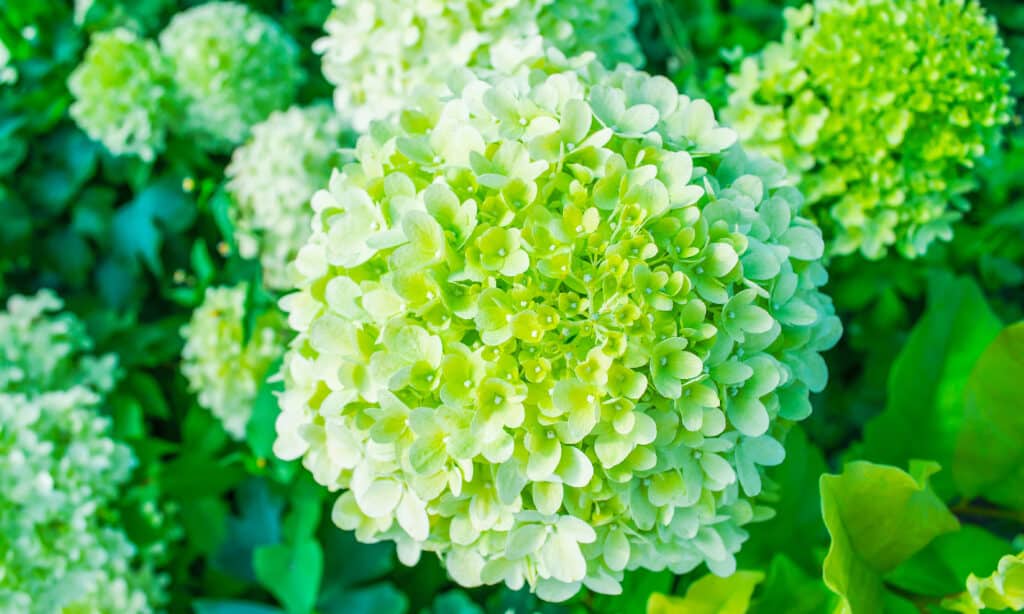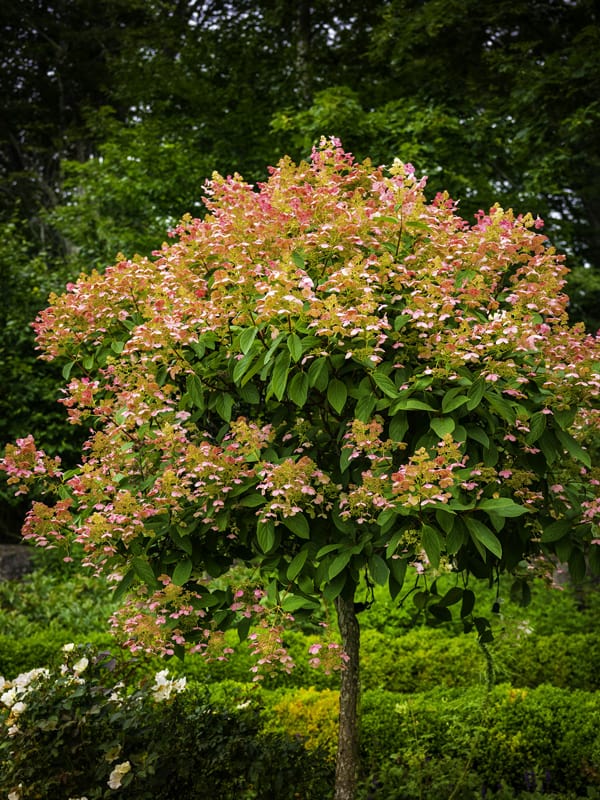Many people consider hydrangeas to be an unrivaled beauty among shrubs for their large flower heads that bloom plentifully in vibrant blue, pink, purple, and white hues. Among these pee gee and limelight hydrangeas are two of the most popular varieties. But how can you know which one you are looking at, and how do you decide which to plant at your home? This article compares and contrasts pee gee and limelight hydrangeas so that you can learn how to identify each type. We will review the main differences, considerations when deciding to cultivate one or the other, and how you can begin growing them in your own garden. So let’s learn about pee gee hydrangea vs. limelight hydrangea!
Comparing Pee Gee and Limelight Hydrangeas

| Pee Gee Hydrangea | Limelight Hydrangea | |
|---|---|---|
| Scientific Name | Hydrangea paniculata ‘Grandiflora’ | Hydrangea paniculata ‘Limelight’ |
| Description | Reaches up to 20 feet tall and 15 feet wide. | Reaches up to 8 feet tall and 8 feet white. |
| Hardiness Zone | 3-8 | 3-9 |
| Origin and Growing Preferences | Originated in Asia, grows best in partial shade to full sun, in moist but drained soil, with watering once or twice per week in periods of drought. | Originated in North America, grows best in partial shade to full sun, in moist but drained soil, with watering once or twice per week in periods of drought. |
Key Differences Between Pee Gee and Limelight Hydrangeas
The main differences between the pee gee and limelight hydrangeas are their origin, size (height) at maturity, and the color of their flowers.
Let’s review these differences in greater detail now.
Pee Gee vs. Limelight Hydrangea: Origin

Pee Gee is native to Asia.
©iStock.com/eastriverstudio
One of the major differences between pee gee and limelight hydrangeas begins with the origin of the two varieties. Hydrangea paniculata ‘Grandiflora’, or pee gee (sometimes spelled “PeeGee”), is a species native to Asia, particularly China, Japan, and Korea, as well as parts of Russia. It was originally introduced to the United States and Europe from Asia in the 1800s and quickly grew in popularity.
On the other hand, though limelight is also a Hydrangea paniculata variation, it is the result of a plant breeder named Pieter Zwijnenburg. Zwijnenburg crossed two different hydrangea varieties in the 1980s, eventually resulting in the new, patented limelight variety. Zwijnenburg won numerous awards for his work, including from the Missouri Botanical Garden and the Pennsylvania Horticulture Society.
Pee Gee vs. Limelight Hydrangea: Height

Limelight hydrangeas grow to eight feet tall.
©iStock.com/Valentyna Tymchenko
When comparing pee gee and limelight hydrangeas, one of the easiest ways to tell the two apart is by comparing the height of the mature plants. Pee gees can often reach 10 feet tall after an equivalent 10 years of growth. However, pee gee hydrangeas have the potential to grow up to 20 or 25 feet tall after several decades of care. You won’t find limelight hydrangeas reaching such astonishing heights. The limelight variety usually grows closer to six feet tall, but rarely grows taller than eight feet even after years of growth.
In both cases, pruning during the spring may result in more beautiful blooms and can allow gardeners to easily control the size of the hydrangea bush.
Pee Gee vs. Limelight Hydrangea: Color

Pee gee flowers change color from white to pink in autumn.
©iStock.com/Sanghwan Kim
Another way to visually identify whether a hydrangea is a pee gee or a limelight is to consider the color of the flowers. Pee gee varieties bloom during the summer with bright white flowers, which keep their shining hue well into the fall. In autumn, when the leaves on the trees are changing color, pee gee flowers will morph from white into a beautiful pink.
Limelight hydrangeas also bloom during the summer, but their initial blossoms are a bright green color that gives the variety its name. Over the course of the season, Limelight blooms will turn white, and then eventually change color in the fall much like pee gees do.
Pee Gee vs. Limelight Hydrangea: Size of Panicles

Limelight flower has smaller panicles.
©iStock.com/ironstuff
Just as the pee gee variety tends to grow taller than its limelight counterpart, pee gee panicles (referring to the branching cluster of flowers) typically grow to be 10 or 12 inches, but can grow as large as 18 inches long with pruning.
Limelight is comparatively smaller, with panicles that grow to be 6 to 8 inches, or slightly longer with pruning.
Pee Gee vs. Limelight Hydrangea: Rate of Growth
Despite the fact that pee gee hydrangeas can grow much taller, one reason why some people may prefer to cultivate the limelight variety is its faster rate of growth. While pee gee grows approximately one foot each year, limelight can add two feet of growth each year and rapidly gain height, before slowing in growth as it reaches maturity.
Pee Gee vs. Limelight Hydrangea: Hardiness
One other difference that should be top of the mind for those deciding which variety to grow is geography. Pee gee grows well in USDA hardiness zones 3-8, making it a great choice for the majority of growers in the United States. Limelight can be grown in USDA hardiness zones 3-9, making it a good choice for gardeners who live in parts of the country with higher temperatures in which pee gee may not thrive, such as the southern United States.
Which Should You Grow?
Ultimately, whether you choose to grow a pee gee or a limelight hydrangea should depend on several factors: the growing climate, whether you are hoping to have a medium-sized bush or a larger flowering tree, and the color of flower you prefer. Both are beautiful additions to any garden!
Up Next
- Are Hydrangeas Poisonous To Dogs or Cats?
- Hydrangea Seeds: Experiment With This Popular Shrub!
- 15 Best Outdoor Perennial Flowers
The photo featured at the top of this post is © iStock.com/Robbie Gorr
Sources
- North Carolina Cooperative Extension, Available here: https://plants.ces.ncsu.edu/plants/hydrangea-paniculata-grandiflora/
- North Carolina Cooperative Extension, Available here: https://plants.ces.ncsu.edu/plants/hydrangea-paniculata-limelight-pp-12874/
- SFGate/Judy Wolfe, Available here: https://homeguides.sfgate.com/care-limelight-hydrangeas-50026.html
- Proven Winners ColorChoice Flowering Shrubs, Available here: https://www.youtube.com/watch?v=sbyViLOlNr0
- The Spruce, Available here: https://www.thespruce.com/limelight-hydrangea-plant-profile-4843269
FAQs (Frequently Asked Questions)
How long does it take limelight hydrangea to mature?
Limelight hydrangeas typically mature after 4-5 years, at which point they reach their full height.
Do limelight hydrangeas bloom in their first year?
After planting your Limelight hydrangeas, ensure that they receive consistent watering. You can expect that they will produce some initial blossoms in their first year, but will grow in size and quantity in the years following.
Thank you for reading! Have some feedback for us? Contact the AZ Animals editorial team.






